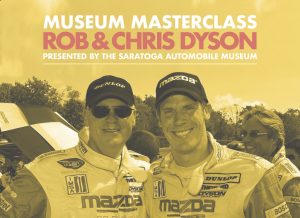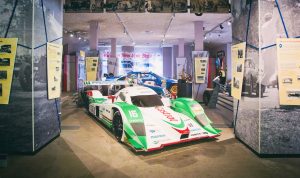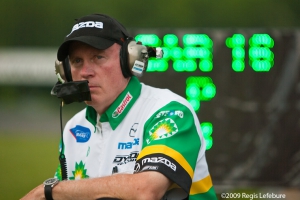Rob Dyson started racing in 1974 – in a hand-built Datsun 510. Last year Dyson Racing won five championships: the American Le Mans Series LMP1 Driver, Team, Engine Manufacturer (Mazda), and Tire (Dunlop) Championships along with the Michelin Green-X Challenge. In between, Rob Dyson and Dyson Racing has been a stalwart force in prototype racing, fielding one of the most successful teams in endurance racing. Few teams can match their lineage and accomplished history. Here is the first of a three-part in-depth interview with team principal, Rob Dyson:
You have been racing for almost forty years. How does this championship year and its five championships compare to others that you have won in the past?
“This was a very special year for the team. It was a culmination of the successful execution of a project that really started three years ago when we started working closely with Mazda, AER and Lola to create a winning package. So a lot of effort went into making this winning year happen and that makes it much more of a season to be savored. I am also very happy for Chris. These are major championships and reflect success at many levels. He was responsible for the range of sponsorships on the car, plus overseeing the team and moving the technical side forward. As a driver, he kept his training up and did not put a wheel wrong all year in addition to handling all the demands that go with wearing many hats.
“The guys on the team did an absolutely great job. Of all the race laps we ran all year, we had a virtually perfect reliability record, only missing it by a couple laps at the end of the year at the Petit Le Mans. And we had no penalties this year – not a single penalty – not on the track or in the pits, and that is a tribute to the team. The guys did a great job at every level this year.
“And it felt good that we were able to give Dunlop, G-OIL, ModSpace and Construct Corps their first major championships. Plus we won the Green X-Challenge which was important to us. So on many different levels, this was a memorable year for Dyson Racing. Everybody at every level associated with the team can say ‘we did it’ and that is what makes this year so special.”
On a personal level, what does racing do for you?
“You know, it is kind of interesting. I have tested but not driven a race car in a race in couple years. I do miss being in the car and I have probably done more races in the past than I am going to in the future. But I love the competition, the execution, the teamwork, the technical aspects and the logistics involved to make it all happen – that is all very satisfying to me. I enjoy the speed, but I do not consider myself a dare devil in that the speed is relative in relation to what your other competitors are doing.
“I view the team as an evolution of where I first started racing in 1974. It is still the same uninterrupted lineage and the same work ethic. When the race team started, it was just me and my wife, Emilie. And than it became me and Pat Smith and than me and Pat and Boz. It was just one of those things that evolved from its start as a small scrappy team where I drove the car, worked on the car, did the fabricating and drove all night to get to the races. No job was too big or too small. And now the race team guys are so competent and so capable. They are carrying the torch that was lit a long time ago.”
Were you able to take some vacation time in the off-season?
“The problem is when a vacation is finished, you end up coming back to such a pile of stuff! It is the aftermath of a vacation that gets to me. I think I continually recharge. One minute I am talking racing on the phone, the next minute I am talking business, than I am talking to someone about a hospital project or a college project. That keeps the energy level up.”
In a recent article, Road & Track called you a racer, businessman, and philanthropist. If you had to pick one, which would you like to be known as?
“Depends on what time of the day it is – whether I am talking to my banker, or a working with a charity or at the race track! Seriously, if I were to analyze all three, I would have to say they are all equally important to me. Philanthropy is exceedingly important as a way of giving back to this great society. We have a great country which has so much going for it and has so many positives. I think it is crucial to give back as much as you can. Being involved in business is energizing for me. It is a competitive enterprise like racing and allows you to build and create value. And racing cars is a great endeavor. Racing is a sport that has all the composites of competition, logistics, and team effort. The racer mentality is a remarkably positive experience in that regardless of what happens, the car has to make the race. It is a very disciplined sport that can be very rewarding. I would have to say my life revolves around all three and is intertwined at all three levels with my family being first and foremost at the top.”
How has racing changed from when you first started to now?
“The sophistication of products for one thing. When I first started we had breaker points and condensers for ignition, now it is all solid-state electronics. When I first started, you could get pump-grade gasoline that is every bit as good as racing fuel you get today. It has changed greatly in the technology and it has changed in the ability to get so much more data now. We have so many different sensors on the car now plus computer simulations and testing equipment that were not even thought of back in the ‘70’s. The cars are a lot more complex which means the skill level of the guys on the crew is higher and the level of competition has increased. Where it has not changed, is that with all of that technology and all that data it still comes down to ultimately how the guy sitting in the race seat gets the car around the racetrack. As sophisticated as race cars are now, if you have a guy who does the job right, it works great and if you have a guy who does not get the job done, you are not going to be as successful. That main ingredient has not changed plus the effort has not changed. These technical advancements do not replace the human effort. You can’t mail it in. The agenda is still the same – to win races and make sure that anyone who beats you has to work for it.”


